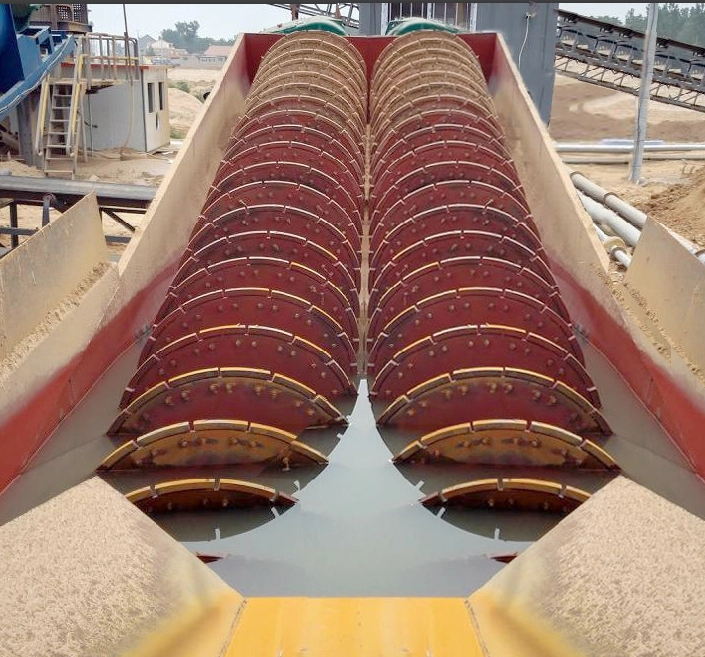spiral classifier
Usage and application :
The spiral classifier is important beneficiation equipment in mineral processing. According to the number of spirals, the spiral classifier can be divided into a single spiral classifier and a double spiral classifier. Spiral classifier is widely used for separating the sand in the ore beneficiation plant to equip with ball mill to form a closed cycle, for classifying ore sand and fine silt in the gravity separation plant, for the granularity classification of the pulp in the metal ore beneficiation flow and for removing the slime and water in the ore washing process.

Working principle:
Classifier is mainly composed of rotating device, helix, tank, lifting mechanism, lower support (bearing) and ore discharge valve.When working, classifier is based on the principle that the size of solid particles is different, the specific gravity is different, and the settling speed in the miscellany liquid is different, and the fine ore particles float in the water into overflow Coarse ore sinks to the bottom of the tank.
The pulp from the tank side of the central inlet into the U-shaped groove, with the spiral of low speed rotation and continuous stirring pulp, so that most of the light and fine particles suspended in the above, overflow weir overflow, known as overflow products;The coarse and heavy particles will settle with the bottom of the chute, and are pushed to the top of the chute by the spiral blade and discharged, and the dehydration will be completed in the conveying process at the same time.If the settling sand enters the grinding mill through the chute, the settling sand enters the grinding mill is returned sand.
Features:
1. Simple structure and wide range of use.
2. Using frequency control technology, efficient and environmentally friendly.
3. Low speed, high production efficiency.
4. Advanced technology, simple process.

Main technical specifications:
|
Model |
Spiral dia (mm) |
Water tank length (mm) |
Spiral rpm (r/min) |
capatity(t/d) |
Motor power (kw) |
Overall dimensions (mm≤) |
Total weight (t) |
||||
|
return sand |
Overflow |
Drive |
lift |
L |
W |
H |
|||||
|
FG-5 |
500 |
4500 |
8-12.5 |
135-210 |
32 |
1.1 |
---- |
5430 |
680 |
1480 |
1.9 |
|
FG-7 |
750 |
5500 |
6-10 |
340-570 |
65 |
3 |
---- |
6720 |
980 |
1820 |
3.1 |
|
FG-10 |
1000 |
6500 |
5-8 |
675-1080 |
110 |
5.5 |
---- |
7590 |
1240 |
2380 |
4.9 |
|
FC-10 |
8400 |
675-1080 |
85 |
7.5 |
---- |
9600 |
1240 |
2680 |
6.2 |
||
|
FG-12 |
1200 |
6500 |
4-6 |
1170-1870 |
155 |
7.5 |
2.2 |
8180 |
1570 |
3110 |
8.5 |
|
FC-12 |
8400 |
1170-1870 |
120 |
7.5 |
2.2 |
10370 |
1540 |
3920 |
11.0 |
||
|
2FG-12 |
6500 |
2340-3740 |
310 |
15 |
4.4 |
8230 |
2790 |
3110 |
15.8 |
||
|
2FC-12 |
8400 |
2340-3740 |
240 |
15 |
4.4 |
10370 |
2790 |
3920 |
17.6 |
||
|
FG-15 |
1500 |
8300 |
4-6 |
1830-2740 |
235 |
7.5 |
2.2 |
10410 |
1880 |
4080 |
12.5 |
|
FC-15 |
10500 |
1830-2740 |
185 |
7.5 |
2.2 |
12670 |
1820 |
4890 |
16.8 |
||
|
2FG-15 |
8300 |
2280-5480 |
470 |
15 |
4.4 |
10410 |
3390 |
4080 |
22.1 |
||
|
2FC-15 |
10500 |
2280-5480 |
370 |
15 |
4.4 |
12670 |
3370 |
4890 |
30.7 |
||
|
FG-20 |
2000 |
8400 |
3.6-5.5 |
3290-5940 |
400 |
11-15 |
3 |
10790 |
2530 |
4490 |
20.5 |
|
FC-20 |
12900 |
3210-5940 |
320 |
11-15 |
3 |
15610 |
2530 |
5340 |
28.5 |
||
|
2FG-20 |
8400 |
7780-11880 |
800 |
22-30 |
6 |
11000 |
4600 |
4490 |
35.5 |
||
|
2FC-20 |
12900 |
7780-11880 |
640 |
22-30 |
6 |
15760 |
4600 |
5640 |
48.7 |
||
|
FG-24 |
2400 |
9130 |
3.67 |
6800 |
580 |
15 |
3 |
11650 |
2910 |
4970 |
26.8 |
|
FC-24 |
14130 |
6800 |
490 |
18.5 |
4 |
16580 |
2930 |
7190 |
41.0 |
||
|
2FG-24 |
9130 |
13600 |
1160 |
30 |
6 |
12710 |
5430 |
5690 |
45.8 |
||
|
2FC-24 |
14130 |
13700 |
910 |
37 |
8 |
17710 |
5430 |
8000 |
67.9 |
||
|
2FG-30 |
3000 |
12500 |
3.2 |
23300 |
1785 |
40 |
8 |
16020 |
6640 |
6350 |
73.0 |
|
2FC-30 |
14300 |
23300 |
1410 |
---- |
---- |
17091 |
---- |
8680 |
84.8 |
||



Get a Quote